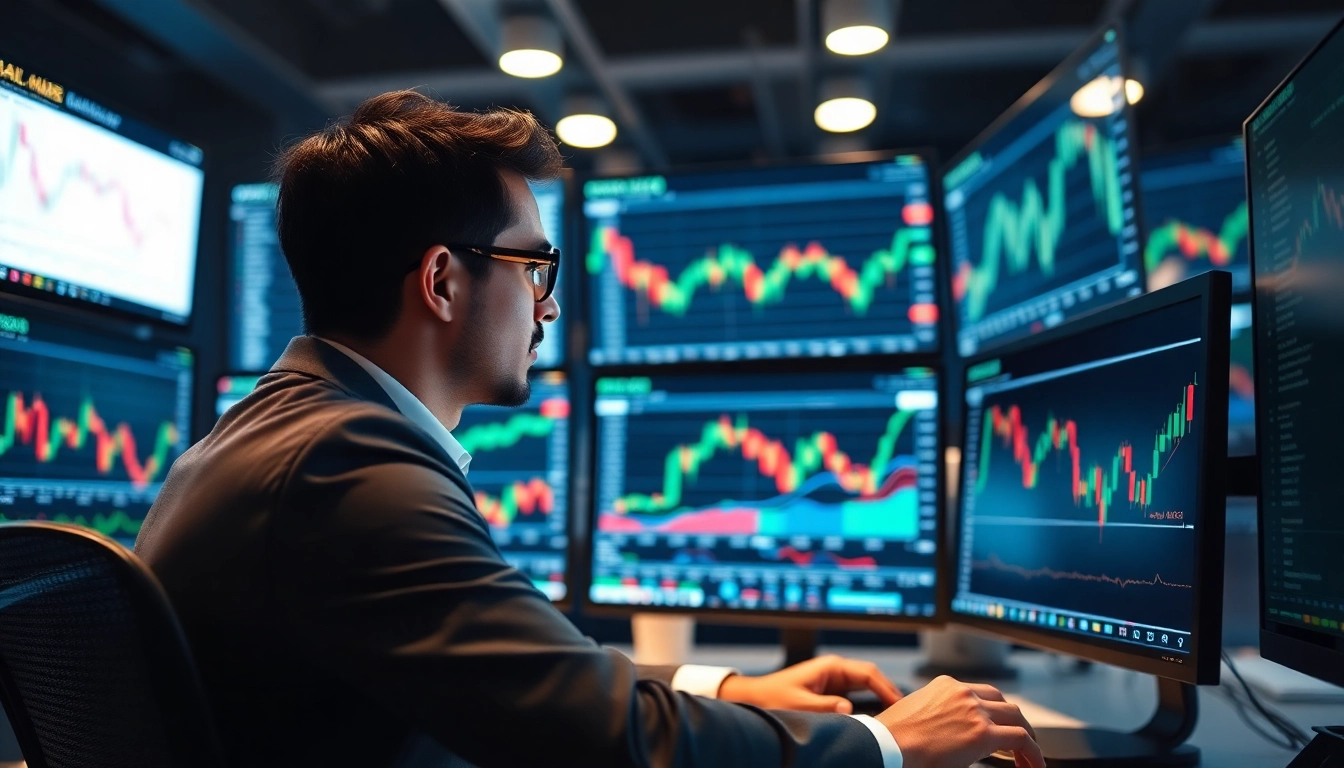Understanding Current Market Movements and Their Impact on Trading Investment News
The global financial landscape continues to exhibit remarkable volatility, with recent trends reflecting a complex interplay between macroeconomic indicators, geopolitical developments, and technological innovations. Notably, stock markets have demonstrated mixed performance, with European shares closing only marginally higher despite significant external pressures, while gold prices surged to new record highs. For investors and traders aiming to stay ahead, it is essential to analyze these fluctuations critically and understand their implications on trading strategies. As part of this effort, accessing timely and accurate Trading Investment News becomes indispensable.
Analyzing Stock Market Fluctuations and Key Indicators
Recent market movements reveal a cautious investor sentiment amid conflicting signals. European indices such as the STOXX 600 narrowly edged up by 0.17%, supported by defense sector gains, yet overall market stability remains fragile. Conversely, U.S. stock futures showed steady trajectories as traders weighed the potential impacts of upcoming U.S. labor data and ongoing geopolitical tensions. Key indicators like the 200-week moving average in cryptocurrencies hint at a bullish outlook for Bitcoin, provided that critical support levels remain intact.
Understanding these signals requires comprehensive analysis of economic data points. For instance, the U.S. Labor Department’s wage and employment figures significantly influence currency and equities markets. A lower-than-expected unemployment rate might bolster consumer confidence, prompting equity rallies, while strong wage growth could hint at looming inflationary pressures, affecting bond yields and the dollar. Continued monitoring of such indicators informs more strategic entry and exit decisions for investors.
Assessing Commodities Like Gold and Oil in Recent Trading News
Commodities have exhibited dynamic shifts recently, driven by macroeconomic uncertainties and geopolitical events. Gold, often considered a safe haven, soared past $3,500 per ounce—its highest level since records began—reflecting heightened investor demand amid inflation fears and dollar weakness. This surge underscores gold’s role in hedging against inflation and currency devaluation.
Meanwhile, oil prices experienced a decline but still maintained a weekly gain, ranging around $68.23 for Brent crude futures. Factors influencing oil include US comments on extending tariffs, China’s weak manufacturing data, and ongoing US-China trade tensions. These factors create a landscape where traders must weigh geopolitical risks against supply-demand fundamentals, making commodities a focal point for diversification and hedge strategies within broader portfolios.
Impact of Macroeconomic Data on Investment Decisions
Global markets are highly sensitive to macroeconomic releases such as inflation rates, GDP growth, and employment figures. US inflation data, in particular, influences the Federal Reserve’s monetary policy stance, affecting interest rate trajectories. Recent US inflation reports have garnered attention as they impact both equities and fixed-income securities. A rising inflation outlook tends to lead to expectations of rate hikes, strengthening the dollar and suppressing bond prices.
Conversely, indications of slowing inflation or even deflationary trends can pave the way for rate cuts, boosting equities and risk assets. Traders thus focus intensely on these reports to calibrate their risk appetite, adjusting portfolios accordingly. Advanced data analytics and real-time news feeds enhance decision-making by providing rapid insights into these critical economic indicators.
Strategies for Navigating Mixed Stock Markets and Volatile Assets
Adapting Investment Portfolios to Market Swings
In a landscape characterized by fluctuating markets, diversification remains the cornerstone of risk mitigation. Investors are advised to rebalance portfolios periodically, emphasizing assets with uncorrelated returns to buffer against volatility. For instance, reallocating from high-risk equities to precious metals like gold, or into inflation-protected securities, helps preserve capital during turbulent times.
Moreover, adopting thematic and sector-based strategies—such as increasing exposure to defense, technology, or commodities—can exploit current trends while managing downside risks. For example, defense stocks often benefit from geopolitical uncertainties, making them suitable hedges in uncertain times.
Leveraging Timely News Updates for Smarter Trading
The importance of real-time news cannot be overstated. Accessing timely updates allows traders to capitalize on market-moving events and avoid detrimental positions. For example, news of regulatory changes, earnings reports, or geopolitical tensions can trigger swift market reactions. Using advanced platforms with integrated news feeds and analytical tools empowers traders to identify opportunities and act decisively.
Implementing automated alerts for significant developments and utilizing technical analysis alongside news sentiments can sharpen trading precision, improving profitability and risk management.
Risk Management Best Practices Amid Market Uncertainty
Effective risk management involves setting stop-loss and take-profit levels based on thorough analysis and maintaining disciplined position sizing. In volatile markets, traders should avoid over-leverage and diversifying trades to prevent exposure to sudden drops.
In addition, employing hedging strategies—such as options or inverse ETFs—is particularly valuable during uncertain periods. Continual review of portfolio risk metrics ensures strategies remain aligned with evolving market conditions, fostering resilience against shocks.
Influence of Global Events and Policy Changes on Trading Investment News
Effects of U.S. Rate Cuts and Geopolitical Tensions
The interplay between monetary policy and geopolitical events significantly shapes market dynamics. Recent speculations about U.S. rate cuts have driven a risk-on sentiment, boosting equities and weakening the dollar temporarily. Conversely, geopolitical tensions—such as conflicts or trade disputes—can induce flight-to-safety trades, elevating gold and causing equities to decline.
Moreover, statements from key policymakers, such as Federal Reserve governors, often influence investor expectations and market volatility, highlighting the importance of following policy communications in real time.
Impact of Regulatory Updates on Cryptocurrencies and Equities
The evolving regulatory landscape continues to drive crypto market sentiment. SEC investigations and regulatory crackdowns, exemplified by Coinbase’s recent revenue dip amid SEC actions, have led to heightened uncertainty. Meanwhile, Facebook (Meta) exploring new partnerships to enhance apps reflects technological innovation and potential new revenue streams, influencing both tech stocks and digital assets.
Understanding regulatory developments enables traders to anticipate shifts and adjust exposure accordingly, balancing risk and opportunity in emerging markets.
Trade Policies and Their Implications on Commodities and Currencies
Trade agreements, tariffs, and sanctions directly impact commodity prices and currency valuation. The US-US China tariff extension and Chinese data releases significantly influence oil, gold, and iron ore markets. For instance, China’s weak manufacturing data has dampened demand outlooks, affecting global supply chains and commodity prices.
Foreign exchange markets also react swiftly to trade policy shifts, with currencies like the yen, euro, and Australian dollar displaying sensitivity to geopolitical headlines. Keeping abreast of these developments allows for strategic positioning, leveraging short-term opportunities arising from policy news.
Emerging Trends and Technologies in Trading and Investment News
The Role of AI and Automation in Financial Reporting
Artificial intelligence and automation are revolutionizing financial markets, providing enhanced data analysis, sentiment detection, and predictive modeling. Meta Platforms’ integration of external AI models exemplifies how tech giants are leveraging AI to optimize internal operations and user engagement.
Investors benefit from AI-driven tools that deliver real-time insights, automate routine analysis, and support systematic trading strategies, increasing efficiency and accuracy in decision-making.
Integrating Real-Time Data for Competitive Edge
Access to high-quality, real-time data sources is critical for maintaining a competitive edge. Sophisticated platforms aggregate news feeds, economic releases, and market data, allowing traders to execute timely and informed trades. Techniques like event-driven trading and sentiment analysis are particularly effective when combined with instant data streams.
Investors should prioritize developing infrastructure that seamlessly integrates multiple data sources, fostering agility and responsiveness in market navigation.
Future Outlook: Digital Currencies and Blockchain Developments
The future of trading is increasingly digital, with cryptocurrencies and blockchain innovation reshaping traditional finance. Governments and institutions are exploring central bank digital currencies (CBDCs), potentially altering cross-border transactions and monetary policy frameworks. As regulations evolve, digital currencies could offer new liquidity, transparency, and efficiency benefits.
Staying ahead involves monitoring blockchain advancements, regulatory stances, and institutional adoption trends to identify emerging opportunities and mitigate risks.
Practical Tips for Investors and Traders Using Trading Investment News
Developing a Resilient Analysis Routine
Constructing a systematic approach to market analysis involves integrating fundamental, technical, and sentiment analysis. Regular review of economic indicators, news updates, and technical patterns allows for well-rounded insights, reducing impulsive decisions.
Investors should also maintain a trading journal to evaluate performance, learn from mistakes, and refine strategies over time, fostering resilience against market shocks.
Utilizing News Sources for Timely Entry and Exit Points
Real-time news feeds and alerts are vital for capitalizing on transient opportunities. Implementing custom notifications for geopolitical events, earnings releases, or regulatory changes enables swift action. Pairing this with technical indicators such as breakouts or volume spikes enhances precision.
This proactive approach minimizes exposure to adverse movements and improves overall trading profitability.
Measuring Success and Adjusting Strategies Based on News Insights
Performance metrics such as win-loss ratio, risk-reward profiles, and portfolio volatility should guide ongoing strategy adjustments. Regular back-testing and simulated trading using recent news scenarios can help validate approaches before real capital deployment.
Adapting strategies in response to changing news and data ensures sustained success and alignment with evolving market landscapes.



